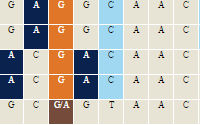Phenotype Annotations Click to see Annotation Detail View
Manual Human Phenotype Annotations - RGDObject Symbol | Species | Term | Qualifier | Evidence | With | Notes | Source | Original Reference(s) | PLAU | Human | Abnormal EKG | | IAGP | | DNA:SNP:3' utr:c.*141C>T (rs4065) | RGD | | PLAU | Human | Arterial stenosis | | IAGP | | DNA:SNP:3' utr:c.*141C>T (rs4065) | RGD | | PLAU | Human | Myocardial infarction | | IAGP | | DNA:SNP:3' utr:c.*141C>T (rs4065) | RGD | | PLAU | Human | Regional left ventricular wall motion abnormality | | IAGP | | DNA:SNP:3' utr:c.*141C>T (rs4065) | RGD | | | |||||||||||||||||||||||||||||||||||||||||||||||||||||
|
|




















